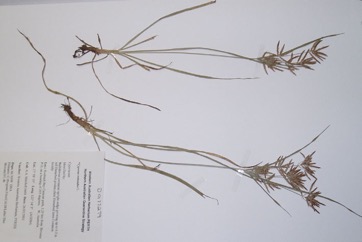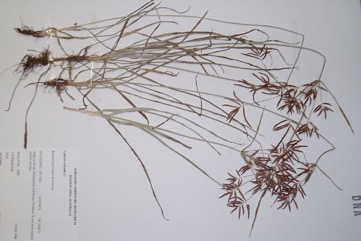Nut Grass, Purple Nutsedge

A tropical plant. It occurs world wide in warmer places. In Papua New Guinea it grows up to 1800 m altitude. In Nepal it grows between 300-2400 m altitude. It grows in moist places. It grows in wetlands. It can grow in most soil types and most pH levels. It cannot tolerate salt or shade. It can grow in arid places. It grows in the Sahara.
Also known as:
Bhada, Chaguan humatag, Chufa roja, Coco grass, Contra cebra, Ei, Gunza, Junquillo, Keya bon, Konnari gedde, Korai, Korrai kizhangu, Kuntayle, Motha, Mothe, Mothee, Mouku, Mumuta, Musta, Mustaka, Mutha, Mutha ghash, Muthanga, Myet-mon-nyin-ahnet, Pupu, Suraj, Tamascal, Tamous-sayt, Te mumute, Teki, Tiririca, Topalak, Tungamuste, Tungegadde, Wet-mye-u, Xiang fu
Synonyms
- Cyperus curvatus Llanos
- Cyperus hexastochyus Rottb.
- Cyperus leptostachyus Griff.
- Cyperus madicans Fl. Graec.
- Cyperus odoratus Osbeck
- Cyperus tenuiflorus Royle (non Rottb.)
Edible Portion
- Tubers, Seeds, Roots, Rhizomes, Culms
Where does Nut Grass grow?
Found in: Afghanistan, Africa, American Samoa, Argentina, Asia, Australia, Balkans, Belize, Bhutan, Bolivia, Bosnia, Botswana, Brazil, British Indian Ocean Terr., BIOT, Burkina Faso, Cambodia, Cameroon, Central Africa, Central America, Central Asia, Chad, Chile, China, East Africa, East Timor, Eswatini, Europe, Fiji, France, Ghana, Greece, Grenada, Guam, Guatemala, Guiana, Guianas, Guyana, Haiti, Himalayas, India, Indochina, Indonesia, Israel, Italy, Japan, Kazakhstan, Kenya, Kiribati, Korea, Kyrgyzstan, Laos, Lesotho, Madagascar, Malaysia, Mali, Marquesas, Mediterranean, Micronesia, Morocco, Mozambique, Myanmar, Namibia, Nauru, Nepal, New Caledonia, New Zealand, Niger, Nigeria, Norfolk Island, North Africa, North America, Northeastern India, Pacific, Pakistan, Panama, Papua New Guinea, PNG, Paraguay, Philippines, Portugal, Rotuma, Sao Tome and Principe, SE Asia, Sierra Leone, Solomon Islands, South Africa, South America, Southern Africa, Spain, Sri Lanka, St Helena, St. Kitts and Nevis, St Lucia, Sudan, Suriname, Swaziland, Taiwan, Tajikistan, Thailand, Timor-Leste, Tonga, Turkey, Tuvalu, Uruguay, United States, Uzbekistan, Venezuela, Vietnam, West Africa, West Indies, West Timor, Zambia, Zimbabwe
Notes: It is mostly regarded as a serious weed in gardens in the tropical lowlands. There are 550 Cyperus species. It is used in medicine.
Status: The roots are chewed especially by children.
Growing Nut Grass, Purple Nutsedge
Cultivation: Plants are grown by seed or tuberous rhizomes. Seeds often do not grow. Rhizomes and tubers are more common methods of reproduction.
Edible Uses: CAUTION: All parts of the plant can contain poisonous cyanide (the bitter taste) so must be well heated before eating. The tubers are eaten fresh. They are also roasted or boiled and can be dried and made into flour. The bases of the culms are cooked and eaten. The rhizomes are cut into small pieces and roasted.
Nutrition Info
per 100g edible portion| Edible Part | Energy (kcal) | Protein (g) | Iron (mg) | Vitamin A (ug) | Vitamin c (mg) | Zinc (mg) | % Water |
|---|---|---|---|---|---|---|---|
| Bulb | 179 | 1.9 | 5.8 | - | 2 | 1.4 | 53.3 |
Nut Grass, Purple Nutsedge Photos


References
Ambasta, S.P. (Ed.), 2000, The Useful Plants of India. CSIR India. p 158
Beckstrom-Sternberg, Stephen M., and James A. Duke. "The Foodplant Database." http://probe.nalusda.gov:8300/cgi-bin/browse/foodplantdb.(ACEDB version 4.0 - data version July 1994)
Bodkin, F., 1991, Encyclopedia Botanica. Cornstalk publishing, p 316
Borrell, O.W., 1989, An Annotated Checklist of the Flora of Kairiru Island, New Guinea. Marcellin College, Victoria Australia. p 20
Brown, D., 2002, The Royal Horticultural Society encyclopedia of Herbs and their uses. DK Books. p 189
Burkill, H. M., 1985, The useful plants of west tropical Africa, Vol. 1. Kew.
Burkill, I.H., 1966, A Dictionary of the Economic Products of the Malay Peninsula. Ministry of Agriculture and Cooperatives, Kuala Lumpur, Malaysia. Vol 1 (A-H) p 746
Cancilla, D., 2018, Ethnobotanical and Ethnozoological Values Desktop Assessment - Eliwana Project. p 11 (As Cyperus bifax)
Chowdhury, A. & Das, A. P., 2014, Conservation through sustainable utilization of wetland leafy vegetables of Terai and Duars, West Bengal, India. International Journal of Advanced Life Sciences (IJALS), 7(4) p 654
Cribb, A.B. & J.W., 1976, Wild Food in Australia, Fontana. p 157
Dashorst, G.R.M., and Jessop, J.P., 1998, Plants of the Adelaide Plains & Hills. Botanic Gardens of Adelaide and State Herbarium. p 194
Duke, J.A., 1992, Handbook of Edible Weeds. CRC Press. p 82
Ertug, F, Yenen Bitkiler. Resimli Türkiye Florası -I- Flora of Turkey - Ethnobotany supplement
Facciola, S., 1998, Cornucopia 2: a Source Book of Edible Plants. Kampong Publications, p 90
Flora of Australia Volume 49, Oceanic Islands 1, Australian Government Publishing Service, Canberra. (1994) p 428
Flora of Pakistan. www.eFloras.org
Flora of Solomon Islands
Fowler, D. G., 2007, Zambian Plants: Their Vernacular Names and Uses. Kew. p 86
Hedrick, U.P., 1919, (Ed.), Sturtevant's edible plants of the world. p 263
Henty, E.E., & Pritchard, G.S., 1973, Weeds of New Guinea and their control. Botany Bulletin No 7, Division of Botany, Lae, PNG. p 36
Jardin, C., 1970, List of Foods Used In Africa, FAO Nutrition Information Document Series No 2.p 74
KING,
Kinupp, V. F., 2007, Plantas alimenticias nao-convencionais da regiao metropolitana de Porto Alegre, RS, Brazil p 75
Kumar, G.M., & Shiddamallayya, N., 2014, Documentation of Wild Plant Tubers as Food Resources in Hassan District, Karnataka, International Journal of Applied Biology and Pharmaceutical Technology. 5(2) p 91
Kumar, R. & Saikia, P., 2020, Wild edible plants of Jharkhand and their utilitarian perspectives. Indian Journal of Traditional Knowledge Vol 19 (2), April 2020, pp 237-250
Kuo, W. H. J., (Ed.) Taiwan's Ethnobotanical Database (1900-2000), http://tk.agron.ntu.edu.tw/ethnobot/DB1.htm
Lamp, C & Collet F., 1989, Field Guide to Weeds in Australia. Inkata Press. p 98
Lazarides, M. & Hince, B., 1993, Handbook of Economic Plants of Australia, CSIRO. p 74
Lim, T. K., 2015, Edible Medicinal and Non Medicinal Plants. Volume 9, Modified Stems, Roots, Bulbs. Springer p 32
Lulekal, E., et al, 2011, Wild edible plants in Ethiopia: a review on their potential to combat food insecurity. Afrika Focus - Vol. 24, No 2. pp 71-121
Malezas Comestibles del Cono Sur, INTA, 2009, Buernos Aires
Manandhar, N.P., 2002, Plants and People of Nepal. Timber Press. Portland, Oregon. p 186
McClatchey, W., Thaman, R., & Vodonaivalu, S., 2000, A Preliminary Checklist of the Flora of Rotuma with Rotuman Names. Pacific Science (2000) Vol. 54, No. 4: 345-363
Misra, R. C., et al, 2013, Genetic resources of wild tuberous food plants traditionally used in Similipal Biosphere Reserve, Odisha, India. Genetic Resources and Crop Evolution. Vol. 60 No. 2. Springer
Morley, B.D., & Toelken, H.R., (Eds), 1983, Flowering Plants in Australia. Rigby. p 367
Murtem, G. & Chaudhrey, P., 2016, An ethnobotanical note on wild edible plants of Upper Eastern Himalaya, India. Brazilian Journal of Biological Sciences, 2016, v. 3, no. 5, p. 63-81
Nassif, F., & Tanji, A., 2013, Gathered food plants in Morocco: The long forgotten species in Ethnobotanical Research. Life Science Leaflets 3:17-54
Paczkowska, G. & Chapman, A.R., 2000, The Western Australian Flora. A Descriptive Calatogue. Western Australian Herbarium. p 46
Pagag, K. & Borthakur, S.K., 2012, Wild edible wetland plants from Lakhimpur district of Assam, India. Pleione 6(2): 322 - 327
PARMENTIER,
Peekel, P.G., 1984, (Translation E.E.Henty), Flora of the Bismarck Archipelago for Naturalists, Division of Botany, Lae, PNG. p 56
Peters, C. R., O'Brien, E. M., and Drummond, R.B., 1992, Edible Wild plants of Sub-saharan Africa. Kew. p 15
Plants for a Future database, The Field, Penpol, Lostwithiel, Cornwall, PL22 0NG, UK. http://www.scs.leeds.ac.uk/pfaf/
Plants of Haiti Smithsonian Institute http://botany.si.edu/antilles/West Indies
Redzic, S. J., 2006, Wild Edible Plants and their Traditional Use in the Human Nutrition in Bosnia-Herzegovina. Ecology of Food and Nutrition, 45:189-232
RIRDC, 2010, New Root Vegetables fo the Native Food Industry, Australian Government RIRDC Publication 9/161
Roger, D. D., et al, 2012, Nutritional properties of “Bush Meals” from North Cameroon’s Biodiversity. Advances in Applied Science Research, 2012, 3 (3):1482-1493
Romanowski, N., 2007, Edible Water Gardens. Hyland House. p 54 and p 56 (As Cyperus bifax)
Royal Botanic Gardens, Kew (1999). Survey of Economic Plants for Arid and Semi-Arid Lands (SEPASAL) database. Published on the Internet; http://www.rbgkew.org.uk/ceb/sepasal/internet [Accessed 16th April 2011]
Ruiters-Welcome, A. K., 2019, Food plants of southern Africa. Ph.D. thesis. Univ. of Johannesburg p 51
Samydurai, P., et al, 2012, Wild habits of Kolli Hills being staple food of inhabitant tribes of eastern Ghats, Tamil Nadu, India. Indian Journal of Natural Products and Resources. 3(3) September 2012 pp 432-437
Saunders, C.F., 1948, Edible and Useful Wild Plants. Dover. New York. p 25
SAXENA,
Simpson, D. A. & Inglis, C. A., 2001, Cyperaceae of Economic, Ethnobotanical and Horticultural Importance: A checklist. Kew Bulletin Vol. 56, No. 2 (2001), pp. 257-360 (Also as Cyperus bifax)
Smith, A.C., 1979, Flora Vitiensis Nova, Lawaii, Kuai, Hawaii, Volume 1 p 249
Sp. pl. 1:45. 1753
Swapna, M. M. et al, 2011, A review on the medicinal and edible aspects of aquatic and wetland plants of India. J. Med. Plants Res. 5 (33) pp. 7163-7176
Swaziland's Flora Database http://www.sntc.org.sz/flora
Tbatou, M, et al, 2016, Wild Edible Plants traditionally used in the countryside of El Jadida, Coastal Area in the Center of Morocco. Life Sciences Leaflets 75:28-48
Terra, G.J.A., 1973, Tropical Vegetables. Communication 54e Royal Tropical Institute, Amsterdam, p 43
Thaman, R.R., 1976, The Tongan Agricultural System, University of the South Pacific, Suva, Fiji. p 394
Thaman, R. R., 1987, Plants of Kiribati: A listing and analysis of vernacular names. Atoll Research Bulletin No. 296
Thaman, R. R, 2016, The flora of Tuvalu. Atoll Research Bulletin No. 611. Smithsonian Institute p 45
Topp, J. M. W., 1988, An Annotated Check List of the Flora of Diego Garcia, British Ocean Territory. Atoll Research Bulletin No. 313
USDA, ARS, National Genetic Resources Program. Germplasm Resources Information Network - (GRIN). [Online Database] National Germplasm Resources Laboratory, Beltsville, Maryland. Available: www.ars-grin.gov/cgi-bin/npgs/html/econ.pl (10 April 2000)
Vernon, R., 1983, Field Guide to Important Arable Weeds of Zambia. Dept of Agriculture, Chilanga, Zambia. p 104
Westerway, J., et al, 2018, Preliminary checklist of the naturalised and pest plants of Timor-Leste. Blumea 63:157-163
Wickens, G.E., 1995, Edible Nuts. FAO Non-wood forest products. FAO, Rome. p160
Wijayakusuma, H.M.H., et al, 1996, Tanaman Berkhasiat Obat Di Indonesia. Pustaka Kartini. p 133
Wild edible plants of Himachal Pradesh
World Checklist of Useful Plant Species 2020. Royal Botanic Gardens, Kew
Yuncker, T.G., 1959, Plants of Tonga, Bernice P. Bishop Museum, Hawaii, Bulletin 220. p 70